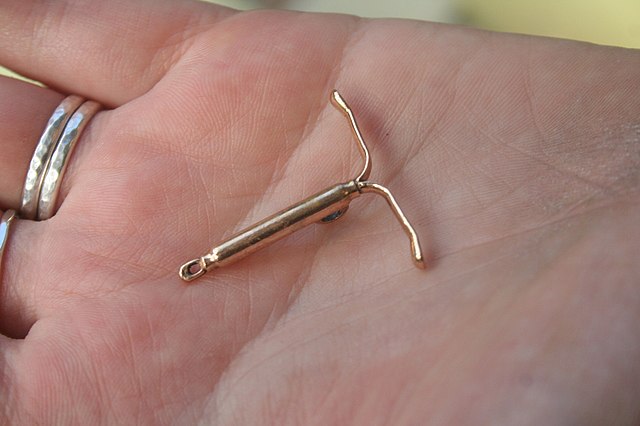|
(Source: Wikimedia) LARC stands for “Long-acting reversible contraceptives”. These are methods of birth control that provide contraception over an extended period without the user having to do anything. They include injections, intrauterine devices (IUDs), and subdermal contraceptive implants, and are the most effective reversible methods of contraception largely due to the fact that their effectiveness is not reliant on patient compliance. The 'typical use' failure rates of IUDs and implants, at less than 1% per year, are about the same as 'perfect use' failure rates. By comparison, the male condom (currently the only reversible method of contraception for sperm-producers) has a ‘perfect use’ failure rate of around 3% and a ‘typical use’ failure rate around 4 times that at 12%. In addition to being long-lasting, convenient, and well-liked by users, they are very cost effective. Typically, LARC users can save thousands of dollars over a five-year period compared to the use of condoms and birth control pills. Despite their safety and effectiveness, though, LARCs are underutilized: only around 14% of women of reproductive age use intrauterine contraception. LARCs are recommended for women of any age no matter how many times they have given birth, and are especially recommended for teens and adolescent users due to their safety and effectiveness, as well as the additional benefits related to menstrual cycle management. Though sperm-producers are biologically not able to take advantage of IUDs, the potential for LARCs designed for these users is very exciting, and there is existing evidence of demand for these types of contraceptives. Several MCI grantees are researching and developing methods within this product category, so we encourage you to visit our website often for updates. As always, though, people considering using LARCs, or any other contraceptive method, should obtain contraceptive counseling from reproductive health professionals. Nuts & Bolts: LARCs To learn more, please visit our series of posts about male reproduction and contraception: Key terms: Intrauterine - within the uterus. Menstrual cycle - the process of ovulation and menstruation in women and other female primates. Subdermal - located or placed beneath the skin; subcutaneous. For additional terminology related to male contraception and the male reproductive system, please visit our glossary: Sources/References: Buhling KJ, Zite NB, Lotke P, Black K; INTRA Writing Group. Worldwide use of intrauterine contraception: a review. Contraception. 2014 Mar;89(3):162-73. doi: 10.1016/j.contraception.2013.11.011. Epub 2013 Nov 25. PMID: 24369300. Mavranezouli I; LARC Guideline Development Group. The cost-effectiveness of long-acting reversible contraceptive methods in the UK: analysis based on a decision-analytic model developed for a National Institute for Health and Clinical Excellence (NICE) clinical practice guideline. Hum Reprod. 2008 Jun;23(6):1338-45. doi: 10.1093/humrep/den091. Epub 2008 Mar 26. PMID: 18372257. Majra J. (2010). Use of condoms: clarifying the message. Indian journal of community medicine : official publication of Indian Association of Preventive & Social Medicine, 35(2), 362. https://doi.org/10.4103/0970-0218.66860 Stoddard, A., McNicholas, C., & Peipert, J. F. (2011). Efficacy and safety of long-acting reversible contraception. Drugs, 71(8), 969–980. https://doi.org/10.2165/11591290-000000000-00000 Peralta O, Diaz S, Croxatto H. Subdermal contraceptive implants. J Steroid Biochem Mol Biol. 1995 Jun;53(1-6):223-6. doi: 10.1016/0960-0760(95)00051-z. PMID: 7626459. Blumenthal, P. D.; Voedisch, A.; Gemzell-Danielsson, K. (2010). "Strategies to prevent unintended pregnancy: Increasing use of long-acting reversible contraception". Human Reproduction Update. 17 (1): 121–137. doi:10.1093/humupd/dmq026 Mestad, R.; Kenerson, J.; Peipert, J. (2009). "Reversible Contraception Update: The Importance of Long-Acting Reversible Contraception". Postgraduate Medicine. 121 (4): 18–25. doi:10.3810/pgm.2009.07.2025 For additional publications related to male contraception and the male reproductive system, please visit our publications page:
0 Comments
Your comment will be posted after it is approved.
Leave a Reply. |
Categories
All
Archives
June 2024
|
|
|
Donate to Male Contraceptive InitiativeYour generous donation makes a difference!
|
© Male Contraceptive Initiative. All rights reserved.


 RSS Feed
RSS Feed
